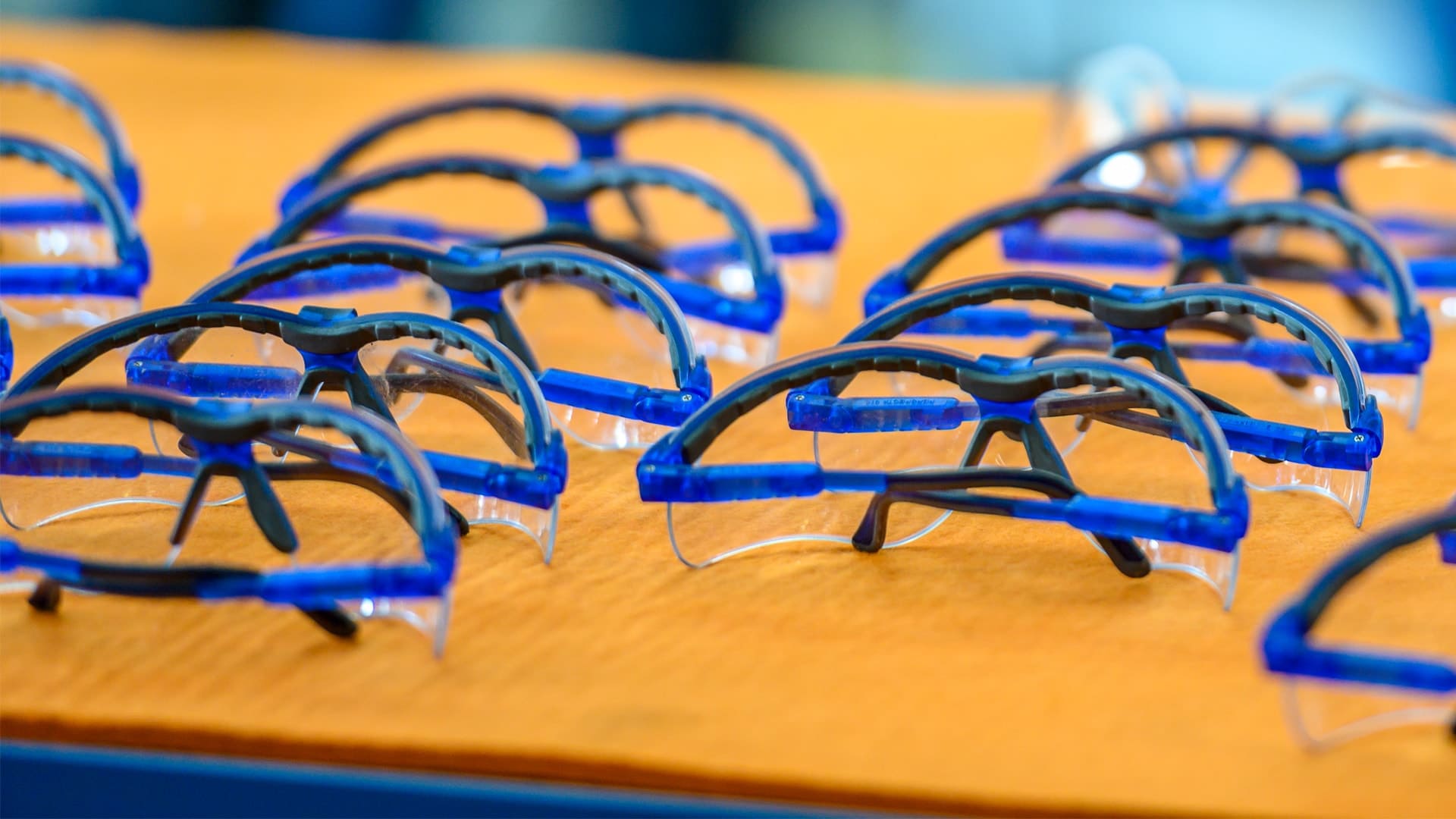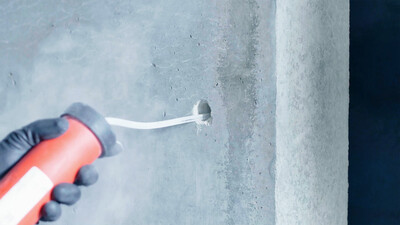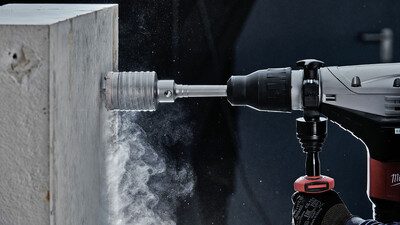Instructions for use rotary hammer drill bits and chisels.
In order to avoid injuries and guarantee the lifetime of the tools, it is important to observe the following application and safety instructions.
General work instructions
Rotary hammer drill bits are primarily used in concrete, masonry, natural stone, etc. They are not suitable for materials such as bitumen, plastic, glue, adhesives and metal. The rotary hammer drill must be guided in a straight line with continuous feed. Lateral pressure must be avoided. Only use concentric tools. Do not forcibly twist drill bits. To avoid breakage around the drilled hole, placing a wooden panel over the material being drilled or masking the drilled hole is recommended.
Drilling with lengths ≥ 450 mm:
For better guidance of these drill bits, predrill to at least 150 mm with a drill bit of a comparable diameter. When drilling deeper than 150 mm, raise the drill bit regularly to remove the drilling dust. This is especially important when drilling vertically downwards. Otherwise there is a risk of compacted drilling dust and the drill bit jamming in the drilled hole.
Drilling with hollow drill bits:
When drilling downwards, it is recommended to begin drilling lightly at first. Then use a drill bit to drill a hole through the material at the bored
indentation. This lets the drilling dust flow unimpeded through the drilled hole and results in faster
drilling progress.
- Drilling in concrete or reinforced concrete:
Concrete is normally strengthened with the reinforcing steel. When drilling rebar, the drill bit should be raised every 10 to 20 seconds. This ensures that the drill bit is undamaged and, more importantly, the steel chips are removed so that the bit can find a new drilling point. As a result, removal power is increased.
If a rotary hammer drill bit fails when drilling rebar, carbide remains in the drilled hole and this can lead to the failure of another rotary hammer drill bit. Therefore, it is absolutely necessary to start the second drilling tool at slow speed and low pressure and to continue drilling cautiously.
In the case of reinforcement collisions and especially when breaking through reinforcement, the rotary hammer drill bits tend to jam. This can lead to carbide chipping. The pressure on the rotary hammer drill bit and the power of the machine should therefore be reduced when breaking through or if the rotary hammer drill bit begins to jam.
- Drilling in granite or on a reinforcement:
Very high heat is created in the drill bit during drilling. All temperatures > 400°C result in damage to the carbide and brazing. This can lead to breakage or loss of the carbide. Therefore, the drill bit should ideally be cooled or given enough time to cool down.
- Drilling in smooth surfaces:
Spot drilling or center punching to prevent drill bit slippage. We recommend the use of our drill bits with special centering tips.
- Drilling in soft or damp materials:
Thumping or congestion effects should be avoided. Raising the drill bit prevents premature wear of the drill bit. Drilling in damp concrete generally results in increased rotary hammer drill bit failures.
- Drilling in other hard materials:
To avoid overheating the drill bit, the tool should be cooled between individual holes.
- Drilling in honeycomb brick:
If honeycomb brick must be drilled with a rotary hammer drill bit, this should be done using machines with low impact energy. Drilling should be carried out at lower power to prevent brick breakage.
- Drilling in glazed materials (tiles, marble, etc.):
The impact gear of the drill must be switched off. We recommend using drill bits with ground positive cutting geometry.
Speed recommendations
There are no precise speed specifications for rotary hammer drills. Only recommendations can be made. The following applies in general: the larger the rotary hammer drill, the lower the speed. To achieve fast drilling progress, drilling at the highest speed is recommended, because the impact rate of the rotary hammer drill is normally linked to the speed.
Pressure
To prevent the machine from jumping, high pressure should be exerted on the rotary hammer drill bit during spot drilling and the machine should be set to the hammer position. Select the pressure on the machine so it does not jump and can work quietly. This is ensured by a pressure of 15 kg to 25 kg. If the pressure is too low, the machine will jump, producing a dead blow. This can result in increased impact energy, which can destroy the drill bit. The rotary hammer drill cannot work properly with excessive pressure. This reduces the service life of the rotary hammer drill and results in increased heat input when hammer drilling.
Service and maintenance
Before insertion into the machine, the insertion end must be cleaned and then lubricated with drill grease (approx. 0.5–1.0 g). This must be observed, especially when using the tool for the first time. This ensures proper functioning of the tool mount and minimal mounting shank wear.
- D-PLUS / D-MAX dustless bit
Before installing an anchor, the remaining material in the drilled hole should be removed so that the anchor can ensure optimal safety. Alternatively, a dustless bit with automatic drill hole cleaning should be used (D-PLUS/D-MAX dustless bit). The recommended impact energy depends on the diameter. An M/H class industrial vacuum cleaner starting at 1200W and 40 l/s volume flow is required. Please observe the detailed operating instructions.
- DreConnect
DreConnect maintenance and care: Very dirty machine mounts, drill bit shanks and DreConnect adapters should be cleaned with special lubricants and care products. Please be sure to observe the relevant details provided in the DreConnect operating instructions.
- Versio tool system
For Versio systems and tapered systems, use only rotary hammer drills up to a maximum of 8 kg.
- UNICut universal hole saws:
Spot drilling at low speed produces a clean, tear-free hole edge.
Recommended machine output:
Ø 25 mm – 50 mm: min. 400 watt
Ø 58 mm – 105 mm: min. 600 – 800 watt
General work instructions
In general, bending and levering lead to failure of the chisel tool and should be avoided. In general, with pointed and flat chisels, it must also be ensured that the tool changes position after approximately 3 seconds, because every flat and pointed chisel tends to jam. The SDS-plus and the SDS-max shank must be greased to prevent heating of the shank and thus its failure.
Material-specific work instructions
In principle, even reinforcement can be cut through with a spade and flat chisel. When doing so, it must be ensured that the chisel is sharp and that the reinforcement is firmly anchored and does not tend to vibrate.
Pressure
To prevent the machine from jumping, high pressure should be exerted on the rotary hammer drill bit during spot drilling and the machine should be set to the hammer position. Select the pressure on the machine so it does not jump and can work quietly. This is ensured by a pressure of 15 kg to 25 kg.
The rotary hammer drill cannot work properly with excessive pressure. This reduces the service life of the rotary hammer drill and results in increased heat input at the chisel.
With too little pressure, the machine jumps. This can lead to injuries.
Product-specific instructions
Our chisels must not be re-hardened. In principle, re-hardening is possible but should only be carried out by qualified specialists. This should only be done if the chisel has lost its hardness due to overloading.
Any heating, friction or defects can lead to a local, new increase in hardness or a notch that can result in failure of the chisel tool.


